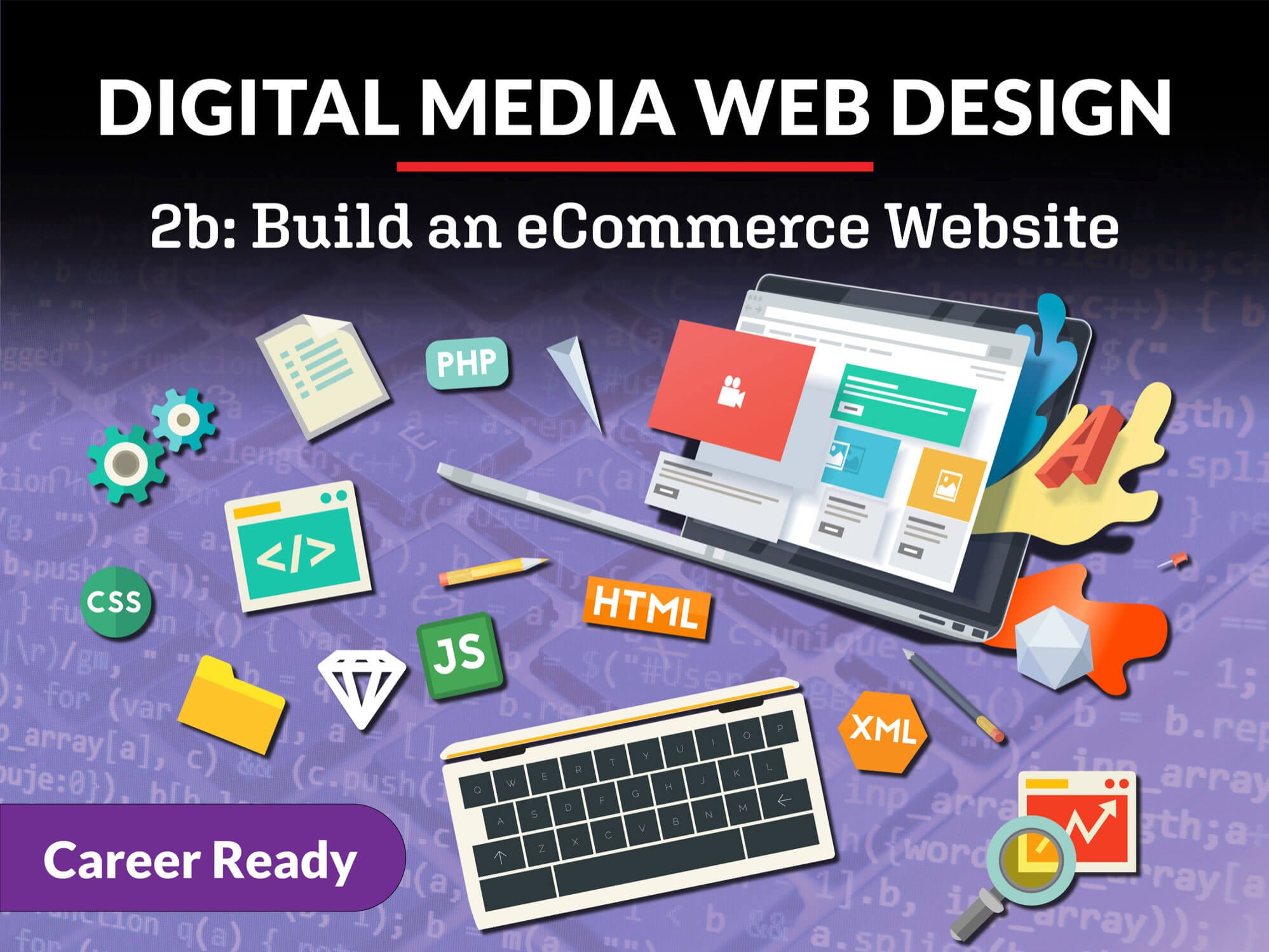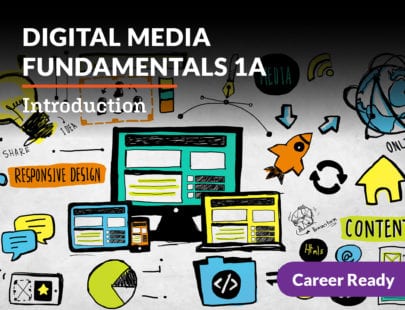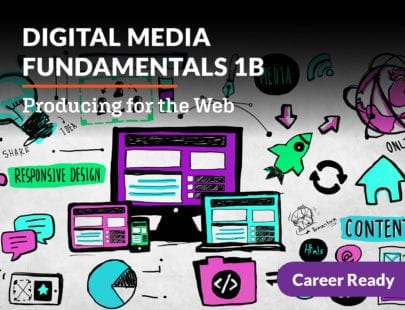
Digital Media Web Design 2b: Build an eCommerce Website
Think of the best online stores you’ve visited. What do you think makes them unique? How do they keep buyers engaged and purchasing? Before you can design a great eCommerce store, it’s essential to understand how one works. Learn the trends, design principles, and security strategies. Explore what it means to adhere to ethical and legal requirements and complying with industry standards and accessibility. It’s time to start designing the next best eCommerce site!
Units at a Glance
Unit 1: Project Management
Effective websites aren’t created in a day—they require planning and process. The bigger the site, the more important the process becomes. Website development teams usually include project managers who keep track of the development process and make sure everyone on the team knows their responsibilities, deadlines, and budgets. Even if you’re working on a small website and you’re the only team member, it’s still advisable to follow the phases of project management throughout the development process.
What will you learn in this unit?
- Identify steps in the web site development process
- Identify components of project management and explain various project management techniques
- Apply project management cycle to a project and begin planning an eCommerce website
Unit 2: Web Development Tools
Popular eCommerce sites make use of all the newest web development trends to attract viewers and persuade them to stay long enough to put items in their shopping carts. That’s why creating an enterprise eCommerce website has often been a complicated undertaking that requires an experienced team with knowledge and skills in programming languages. However, the rise of easy-to-use GUI-based web development platforms have made it possible for anyone—even someone with very little experience in web development—to create a stunning eCommerce site that can do all the same tricks as the leading eCommerce sites that were built with a big team and a massive budget.
What will you learn in this unit?
- Identify the languages, software platforms, and applications used to build enterprise-level websites at each phase of the development process
- Describe the basic functions of the most popular GUI-based platforms for building an eCommerce website
- Choose the best web building software for your purposes based on a review of features
Unit 3: Website Standards and Accessibility
As you’re planning and designing your eCommerce site, there are many important things to think about, including the ethical and legal issues involved in web development. As someone hosting a business online, an eCommerce store, you’ll want to follow laws like the Copyright Act and the Americans with Disability Act. It’s also important to follow the industry standards set by the W3C for issues involving privacy, property ownership, usability, and accessibility.
What will you learn in this unit?
- Describe the ethical and legal issues that must be considered when developing an eCommerce website.
- Consider intellectual property issues when creating web pages.
- Design web pages to W3C industry standards.
- Follow best practices for creating accessible websites.
Unit 4: Understanding eCommerce
Before you can design an effective online storefront, it’s important to understand how eCommerce works, and to do that, you must be able to define some important industry terms and phrases. If you want to attract customers and encourage multiple visits, it’s important to stay on top of the trends in digital media and eCommerce. It’s a fast-moving industry, and customers expect you to stay up to date with new technology. The market space is crowded with competition, so it’s quite easy for customers to find other stores offering similar products. The most important means of attracting and keeping customers is to develop a clear brand identity for your company that is communicated through the design and style of your site and the digital media you feature on it.
What will you learn in this unit?
- Describe emerging trends in eCommerce and the importance of eCommerce to business and industry
- Explain the importance of branding for an eCommerce website
- Identify the basic components of an eCommerce site
Unit 5: Designing Your eCommerce Site
Once you’ve determined what your eCommerce brand stands for and how you’ll communicate it with a brand statement, color palette, and a logo, it’s time to design the layout of each page on your site. Each page is an opportunity to teach your customers about your brand and to make it appealing to them. You can do that with some basic knowledge of the principles of visual design for websites, including layout, flow, proximity, alignment, white space, and repetition. As you design, it’s of utmost importance to keep your customers in mind—design for them and make sure your site is intuitive and easy to use.
What will you learn in this course?
- Identify and use online tools to design an eCommerce site and add digital media
- Describe and use principles of web design to meet customer expectations
- Design an eCommerce storefront with effective navigation, usability, and accessibility
Unit 6: Create an eCommerce Website
Now that the planning phase is over, it’s time to start building the pages of your eCommerce website. Keep your customer at the center of everything you do, from last minute design decisions to how you write the text that describes your products. If you want your online store to be a success, you must commit to creating pages that are both engaging and interactive for your target market.
What will you learn in this unit?
- Choose effective design trends to add to an eCommerce website
- Enhance an eCommerce website with images and multimedia
- Add interactivity and safety features to an eCommerce website
Unit 7: Securing, Testing, and Launching an eCommerce Site
Because you’re expecting to exchange products and services for money on your site, security and testing are critical parts of your web development process. Security is important for your customer, to keep their financial information safe, and for you, to keep the site and the information it collects safe from hackers. Testing is important in both the pre- and post-launch phases of web development to ensure that users will encounter a site that works and is easy to use. Once your site is launched and receiving customers, it’s important to analyze how the site is performing and to update and maintain it in top form to make sure customers want to keep coming back.
What will you learn in this unit?
- Understand security risks and best practices for securing an eCommerce website
- Practice quality assurance of an eCommerce website by proofreading and testing for functionality, usability, load time, compatibility, and accessibility
- Launch, maintain, and back up an eCommerce website
Unit 8: Marketing Your Site
Now that you’ve planned, designed, created, and launched your eCommerce site, you need to drive traffic to it. The best way to promote an online store is through online communication—that’s where your customers are. But how can you find them? If you commit time to marketing your site, you don’t even have to pay for advertising. There are plenty of free things you can do to promote your products. Put together a solid marketing strategy that includes best practices, social media marketing, and search engine optimization.
What will you learn in this unit?
- Identify opportunities and issues related to developing your customer audience.
- Use best practices for marketing an eCommerce store
- Close an eCommerce website project with a final presentation
Required Materials
Software
- Word processing software
- A free color palette picker (like Adobe’s at color.adobe.com)
- Google Drawings (requires login)
- Capability to clip or take screen shots
- GUI-based web page builder
- Access to two social media platforms



